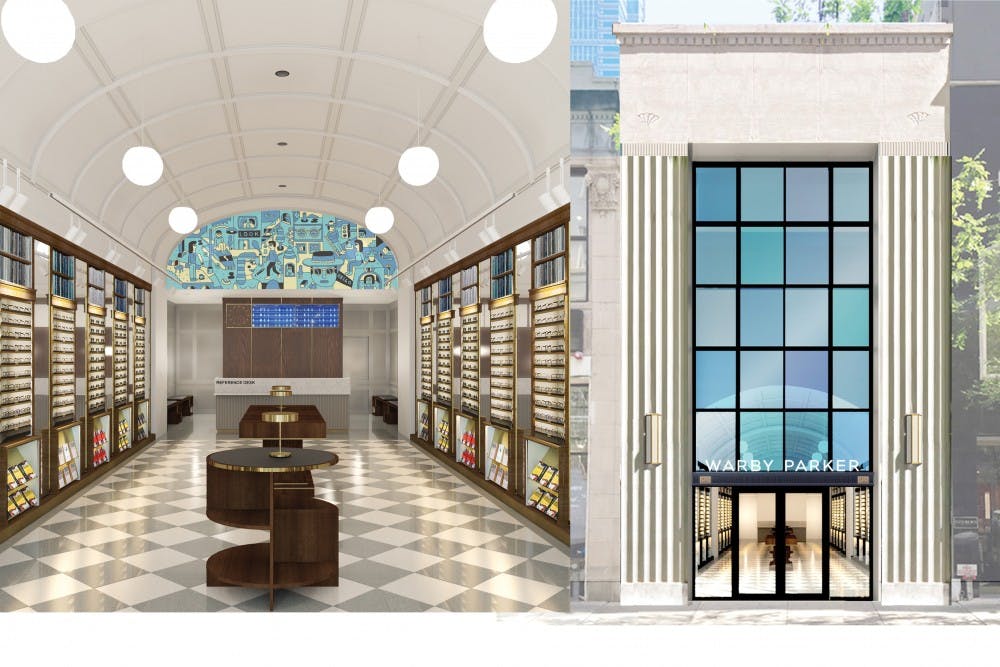Warby Parker’s very first makeshift showroom was a small apartment in Center City.
This Saturday, the brand will open its first Philadelphia store, blocks away from where it began on Walnut Street in 2010.
2010 MBA graduates Dave Gilboa, Neil Blumenthal, Andy Hunt and Jeff Raider founded Warby Parker during their time at Wharton, when they discovered their shared frustration with the high prices and inconvenience of buying eyeglasses.
Gilboa had lost a $600 pair of glasses while backpacking in Southeast Asia in the months before coming back to Penn. The four founders decided to put their savings toward starting the company and opened their first showroom inside Blumenthal’s Walnut Street apartment.
“The business has grown rapidly since then, and we have over a thousand employees and are coming up on 50 retail stores,” Gilboa said. “We thought we’d be selling one to two pairs of glasses a day, and joked that if nothing else, my mom would buy a hundred pairs from us and make us feel okay about ourselves.”
The Walnut Street store will evoke feelings of being inside a library, as the founders have always associated glasses with literature and intellectual curiosity — the company’s name derives from an unpublished Kerouac manuscript. The store will also feature the color blue to pay homage to the Blue-Footed Boobie — a source of inspiration for the company.
“If you look at the top half of the bird, it looks very formal ... almost like a penguin wearing a tuxedo,” Gilboa explained. “But then it has bright pops of blue on its feet and a quizzical look on its face. Similarly, we’ve always tried to incorporate things that are a bit unexpected into our brand, our store design and our glasses design.”
Gilboa and Blumenthal are currently the co-CEOs of Warby Parker. While they have achieved great success now, their path was not always so smooth.
“Any entrepreneurial journey has a lot of ups and downs, and can feel like riding a rollercoaster most of the time,” Gilboa said, adding that the four friends use each other as a support system.
Warby Parker was featured in GQ and Vogue when the company first launched, and the founders were completely caught off guard with how impactful national press can be.
“We ended up hitting our first year sales target in three weeks, and then we were basically stocked out of inventory,” Gilboa said. “We had a waitlist of 20,000 customers, and didn’t have any employees or an office. We had no way to keep up with demand.”
Gilboa, Blumenthal, Hunt and Raider went out of their way to ensure that their early customers knew the founders cared about them and wanted them to walk away with a positive experience, even if it took a few months to get inventory back in stock.
“We reached out to every single person on the waiting list,” Gilboa said. “We gave away free glasses even though we didn’t have any money at the time and were watching every penny.”
Giving back was always a part of Warby Parker’s company vision. Through their “Buy a Pair, Give a Pair” program, they have donated over a million pairs of glasses to people in need and partnered with nonprofits all over the world. Gilboa described the program as the “DNA of the company.”
“From the beginning, we were excited by the prospect of starting a for-profit business that did good in the world. We realized that what was going to keep us motivated was being successful in creating an organization that had more impact as it scaled.”
Warby Parker’s founders have also been cognizant of giving back to the Penn community, including mentoring students and speaking at events such as the 2015 Wharton MBA graduation.
“We get a lot of questions from people who want to become entrepreneurs and are looking for an idea,” Gilboa said. “That’s a backwards way of looking at things.”
“It should start by identifying a need and then thinking about creating a solution.”









